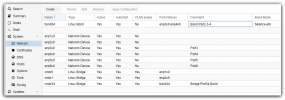Hi,
Hope you can help me solve why only one ports is active at a time in a bonded virtual bridged port.
I have PVE on a bare metal unit with 6 intel I211 ports.
In a bonded pair, it seems like only one port is active at a time.
The config in the interfaces file is for LACP mode which, from what I thought, is supposed to provide load balancing and fault tolerance and so should allow both ports to operate together as one virtual port.
I've configured the network as ;
Port 1 - Management with Linux bridge vmbr0
Port 2 - Wan with Linux bridge vmbr1
Ports 3&4 - Bonded LACP(802.3ad) as vmbr34
Ports 5&6 - unused for now but have plans for them once I get the bonded ports 3&4 working.
All are active with Autostart and the Bridge's are all vlan aware.
What's strange though is the bonded ports only seem to work for the first device connected to one of the pair, regardless of which one is connected first.
e.g. for bonded ports 3&4 as vmbr34;
- I can connect an access point to port 3 then connecting anything (like a managed switch) to port 4 doesn't work (unidentified network and no ip assigned from DHCP)
or
- I can then take the managed switch from port 4 and plug it into port 3 and it will work, then connecting the AP to port 4 doesn't work.
or
- Similarly starting with the AP in port 4 on it's own will work but connecting the managed switch into port 3 afterwards doesn't work.
This seems to act more like active-backup rather than LACP !
interfaces file
(not the full interfaces file - it's a subset for the relevant ports):
auto lo
iface lo inet loopback
auto enp3s0
iface enp3s0 inet manual
#Port3
auto enp4s0
iface enp4s0 inet manual
#Port4
auto bond34
iface bond34 inet manual
bond-slaves enp3s0 enp4s0
bond-miimon 100
bond-mode 802.3ad
bond-xmit-hash-policy layer2+3
#Bond Ports 3-4
auto vmbr34
iface vmbr34 inet manual
bridge-ports bond34
bridge-stp off
bridge-fd 0
bridge-vlan-aware yes
bridge-vids 2-4090
#Bridge Port34 Bond
Also, I have a pfsense vm with vlans and dhcp configured in pfsense which is working fine and is serving dhcp IPs to whichever is the first device to connect to the bonded pair. I just can't seem to get the 2nd port active at the same time.
It might be better to use balance-rr or balance-alb but I'm not sure if they also work with bond-xmit-hash-policy layer2+3
I've been tearing my hair out with this and would appreciate any help.
Thanks in advance
Gav
Hope you can help me solve why only one ports is active at a time in a bonded virtual bridged port.
I have PVE on a bare metal unit with 6 intel I211 ports.
In a bonded pair, it seems like only one port is active at a time.
The config in the interfaces file is for LACP mode which, from what I thought, is supposed to provide load balancing and fault tolerance and so should allow both ports to operate together as one virtual port.
I've configured the network as ;
Port 1 - Management with Linux bridge vmbr0
Port 2 - Wan with Linux bridge vmbr1
Ports 3&4 - Bonded LACP(802.3ad) as vmbr34
Ports 5&6 - unused for now but have plans for them once I get the bonded ports 3&4 working.
All are active with Autostart and the Bridge's are all vlan aware.
What's strange though is the bonded ports only seem to work for the first device connected to one of the pair, regardless of which one is connected first.
e.g. for bonded ports 3&4 as vmbr34;
- I can connect an access point to port 3 then connecting anything (like a managed switch) to port 4 doesn't work (unidentified network and no ip assigned from DHCP)
or
- I can then take the managed switch from port 4 and plug it into port 3 and it will work, then connecting the AP to port 4 doesn't work.
or
- Similarly starting with the AP in port 4 on it's own will work but connecting the managed switch into port 3 afterwards doesn't work.
This seems to act more like active-backup rather than LACP !
interfaces file
(not the full interfaces file - it's a subset for the relevant ports):
auto lo
iface lo inet loopback
auto enp3s0
iface enp3s0 inet manual
#Port3
auto enp4s0
iface enp4s0 inet manual
#Port4
auto bond34
iface bond34 inet manual
bond-slaves enp3s0 enp4s0
bond-miimon 100
bond-mode 802.3ad
bond-xmit-hash-policy layer2+3
#Bond Ports 3-4
auto vmbr34
iface vmbr34 inet manual
bridge-ports bond34
bridge-stp off
bridge-fd 0
bridge-vlan-aware yes
bridge-vids 2-4090
#Bridge Port34 Bond
Also, I have a pfsense vm with vlans and dhcp configured in pfsense which is working fine and is serving dhcp IPs to whichever is the first device to connect to the bonded pair. I just can't seem to get the 2nd port active at the same time.
It might be better to use balance-rr or balance-alb but I'm not sure if they also work with bond-xmit-hash-policy layer2+3
I've been tearing my hair out with this and would appreciate any help.
Thanks in advance
Gav
Last edited:




